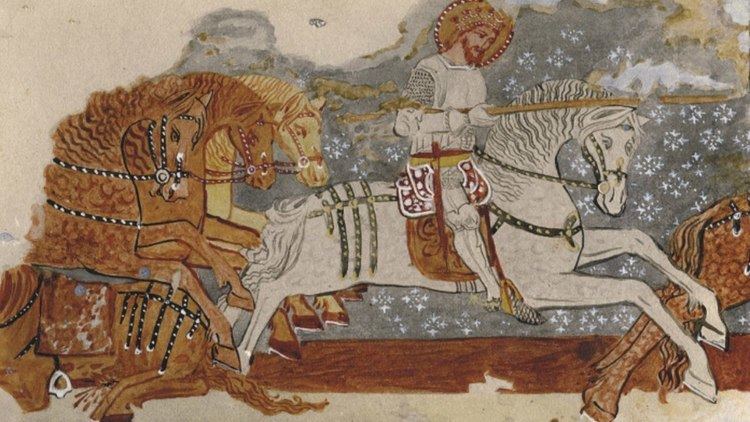 | ||
An episode from the Legend of Saint Ladislaus provided the subjects for numerous murals painted in medieval churches in Hungary during the 14th to 16th century.
Contents
Historical background
Ladislaus I of Hungary was a chivalrous king in Hungary in the 11th century. Before becoming the ruler, together with his brother Géza, and king Solomon of Hungary, he fought in Transylvania against armies of Pechenegs and Cumans invading from the steppes. In the story illustrated by the murals, at the Kerlés battlefield Ladislaus observed that a warrior tried to abduct a Hungarian girl. The royal saint pursued and overcame the warrior and liberated the girl.
Sequence of the images in the Saint Ladislaus legend mural
The sequence of the events portrayed is generally similar all over the churches in medieval Hungary.
The Saint Ladislaus legend in the medieval churches of Hungary
Archaeologist Gyula László collected the documents of fifty churches all around the Carpathian basin, where mural had been painted in medieval churches in Hungary. Some of them had been demolished (for example the churches at Homoródszentmárton and Homoródokland), but some of them had been copied in 19th century sketches by József Huszka. These are preserved in the National Heritage Protection Office in Hungary.
Most of the murals were painted during the reigns of Charles I of Hungary, Louis I of Hungary, and Sigismund, Holy Roman Emperor. During their period of rule Saint Ladislaus became the ideal of the ruler kings therefore these kings chose their burying-place at the cathedral of Nagyvárad.
Eurasian connections
Several scenes of the Saint Ladislaus legend occur in archaeological finds from all over Eurasia. The best known is the Hun-Scythian belt buckle in the Hermitage, Saint Petersburg, Russia. There the resting scene can be seen. The most frequently occurring scene is the wrestling without arms. It also occurs, that the horses of the two warriors also fight against each other. Several belt buckles are with this scene from Ordos, China. The wrestling scene also occurs in the silver plate of Vjatka, Siberia.
Mythological interpretation
Before Gyula László, Géza Nagy suggested that an ancient Eurasian myth is behind the Christianized mural painting. The old myth is expressed by the fight between the two heroes representing light and darkness. In the literature the ballad of Anna Molnár also is related to the Saint Ladislaus legend.
